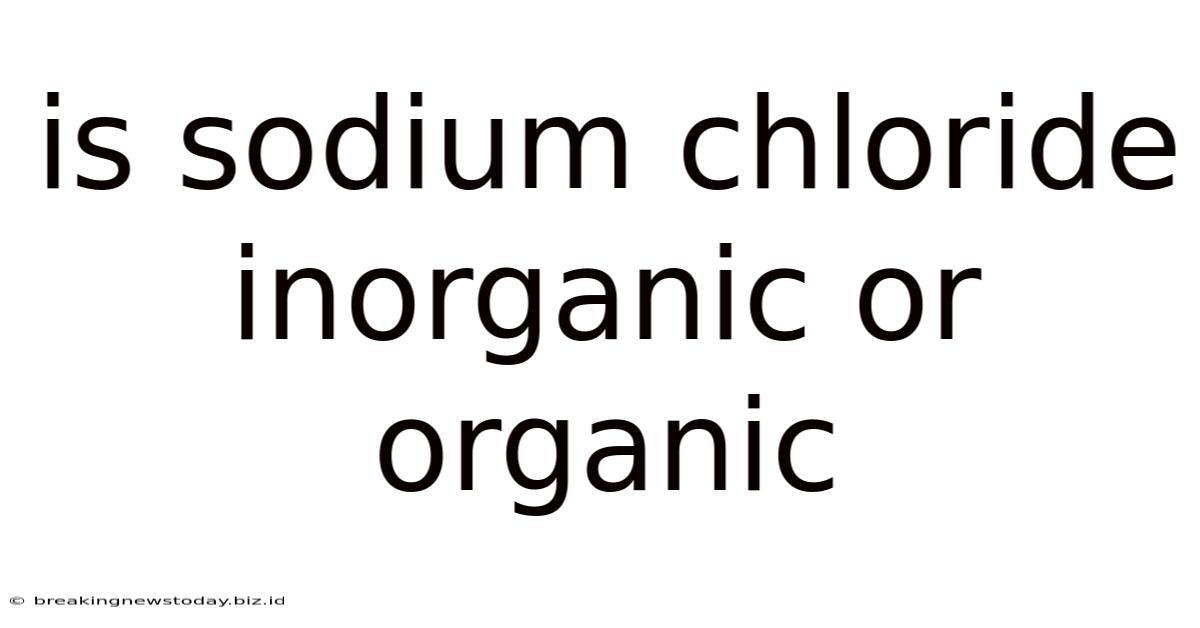Is Sodium Chloride Inorganic Or Organic
Breaking News Today
May 24, 2025 · 4 min read

Table of Contents
Is Sodium Chloride Inorganic or Organic? A Deep Dive into Chemical Classification
The question of whether sodium chloride (NaCl), commonly known as table salt, is inorganic or organic might seem straightforward at first glance. However, a deeper understanding of the distinctions between organic and inorganic compounds reveals a more nuanced answer. This article will explore the fundamental differences between organic and inorganic chemistry, delve into the chemical structure and properties of sodium chloride, and definitively answer the central question. We'll also explore some related concepts and common misconceptions to provide a comprehensive understanding of this topic.
Understanding the Organic/Inorganic Divide
The classification of a compound as organic or inorganic hinges on the presence or absence of carbon atoms bonded to hydrogen atoms. This seemingly simple criterion, however, has a rich historical context and some exceptions.
The Early Days of Organic Chemistry: Vitalism
Initially, the distinction between organic and inorganic chemistry was rooted in the concept of vitalism. Vitalists believed that organic compounds could only be produced by living organisms, possessing a "vital force" absent in inorganic materials. This idea was overturned in 1828 by Friedrich Wöhler, who synthesized urea, an organic compound, from inorganic ammonium cyanate. This landmark experiment demonstrated that organic compounds could be synthesized without the need for a living organism, effectively shattering the vitalistic paradigm.
The Modern Definition: Carbon's Crucial Role
The modern definition focuses on the presence of carbon-hydrogen (C-H) bonds. Organic compounds are defined as those containing carbon atoms bonded to hydrogen atoms, often forming complex structures. This definition is not absolute; some carbon-containing compounds, such as carbonates (like calcium carbonate, CaCO₃) and cyanides (like sodium cyanide, NaCN), are considered inorganic because they lack C-H bonds. These exceptions highlight the importance of considering the overall chemical structure and bonding rather than solely focusing on the presence of carbon.
Key Differences Between Organic and Inorganic Compounds
While the presence or absence of C-H bonds serves as the primary differentiating factor, several other characteristics tend to distinguish organic and inorganic compounds:
-
Bonding: Organic compounds are primarily characterized by covalent bonds, where atoms share electrons. Inorganic compounds often exhibit ionic bonds, where electrons are transferred between atoms, resulting in the formation of ions. However, this is not a rigid rule, as many inorganic compounds also have covalent bonds (e.g., silicon dioxide, SiO₂).
-
Melting and Boiling Points: Organic compounds generally have lower melting and boiling points than inorganic compounds due to the weaker intermolecular forces between covalently bonded molecules. Inorganic compounds, with their stronger ionic bonds, often exhibit higher melting and boiling points.
-
Solubility: Organic compounds tend to be soluble in nonpolar solvents, like hydrocarbons, while many inorganic compounds are soluble in polar solvents like water. This difference stems from the nature of the intermolecular forces involved.
-
Flammability: Many organic compounds are flammable, while most inorganic compounds are not. The presence of readily oxidizable C-H bonds in organic molecules contributes to their flammability.
-
Complexity: Organic compounds often exhibit a greater degree of structural complexity compared to inorganic compounds, forming long chains, rings, and branched structures. This complexity arises from the ability of carbon atoms to form four covalent bonds.
The Case of Sodium Chloride: A Definitive Answer
Now, let's return to the central question: Is sodium chloride inorganic or organic? The answer is unequivocally inorganic. Sodium chloride (NaCl) lacks carbon-hydrogen bonds. It consists of sodium (Na⁺) and chloride (Cl⁻) ions held together by strong ionic bonds. It exhibits typical characteristics of inorganic compounds: a high melting point, solubility in water, and non-flammability. Its structure is a simple crystal lattice, lacking the complex molecular arrangements seen in many organic compounds.
Addressing Common Misconceptions
Several misconceptions regarding organic and inorganic compounds frequently arise. Let's address some of them:
-
All carbon-containing compounds are organic: This is false. As mentioned earlier, compounds like carbonates and cyanides contain carbon but are classified as inorganic due to the absence of C-H bonds.
-
Organic compounds are always derived from living things: This is a remnant of the vitalistic theory. While many organic compounds are found in living organisms, countless synthetic organic compounds are created in laboratories.
-
Inorganic compounds are always simple: While many inorganic compounds have relatively simple structures, many others exhibit complex structures and properties. For instance, zeolites are inorganic compounds with complex three-dimensional structures used in various applications.
Conclusion: Simplicity and Clarity
The classification of a compound as organic or inorganic is based on a fundamental criterion: the presence or absence of carbon-hydrogen bonds. Sodium chloride, lacking C-H bonds and exhibiting characteristic properties of inorganic compounds, is firmly categorized as inorganic. Understanding the historical context, the modern definition, and the key differences between organic and inorganic chemistry provides a clear and concise answer to this question, dispelling any lingering misconceptions about this crucial aspect of chemical classification. The simplicity of the answer doesn't diminish the importance of understanding the vast and complex world of chemistry that encompasses both organic and inorganic compounds. Each branch contributes uniquely to our understanding of the natural world and fuels innovation in numerous fields.
Latest Posts
Latest Posts
-
Which Of The Following Is A Valid Conversion Factor
Jun 01, 2025
-
Calculating Net Force P 19 Answer Key
Jun 01, 2025
-
Which Answer Best Defines Employee Benefits
Jun 01, 2025
-
Determine The Poh Of A 0 00598 M Hclo4 Solution
Jun 01, 2025
-
All Of The Following Are True Regarding Dc Power Except
Jun 01, 2025
Related Post
Thank you for visiting our website which covers about Is Sodium Chloride Inorganic Or Organic . We hope the information provided has been useful to you. Feel free to contact us if you have any questions or need further assistance. See you next time and don't miss to bookmark.